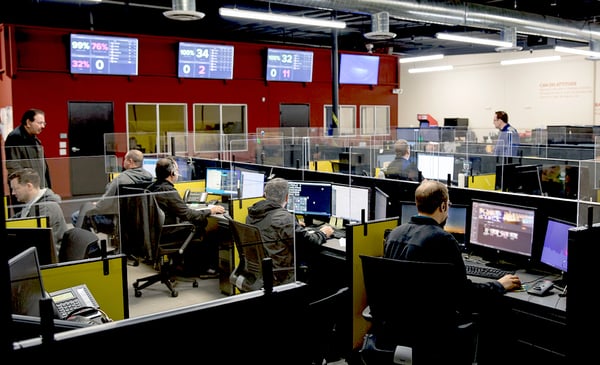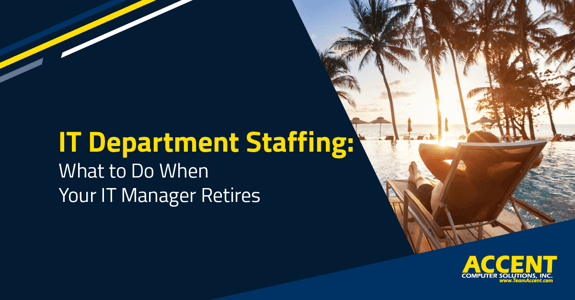You've had an information technology (IT) manager on staff for the last 15 years, and they just told you that they're retiring. They know your business and your systems intimately – they might have even built them!
So, how will you fill their shoes? How will you get what you need when they're gone?
The good news: Retiring employees generally give you ample notice.
This gives you the opportunity to fully assess the situation and plan for a smooth transition. When employees leave voluntarily, and you part ways amicably, transferring the knowledge to a new person or company should be much easier.
You also get the opportunity to reevaluate the position entirely.
With IT, you typically have three choices to staff your IT department:
- Hire a New IT Manager (In-House)
- Hire a Managed IT Services Company (Outsourced)
- Hire In-House IT Staff and Partner with a Managed IT Services Company (Hybrid)
🔎 Related: In-House or Managed IT Services is the Wrong Question
In any case, planning should begin immediately. You'll need a process for evaluating your options and how you'll make your decision.
Option 1: Hire a New IT Manager (In-House)
If you decide the position should be filled by another in-house employee, start recruiting as soon as possible. With "The Great Resignation” affecting businesses across the country, it could take time to find the right person to fill the position.
Another thing to keep in mind during the hiring process is that the role of the in-house IT manager has evolved.
If you’ve had an IT manager on staff for several years, you’re likely used to having them in the office working on projects, helping end-users, and a myriad of other tasks. Today, much of that can be done remotely. IT manager job candidates will likely expect flexibility in their work location and schedule like we’re seeing with roles in other departments these days.
Once you've selected the perfect candidate, it's ideal that they work alongside the retiring IT manager for about a month, if possible.
This gives the new hire the ability to fully understand how things are configured, how to troubleshoot your systems, and where the organization's information technology stands overall. The amount of time they should shadow the retiring IT manager will depend on the amount of readily available documentation.
If the existing manager has thorough network documentation, getting a new person up to speed will be a much faster process.
Option 2: Hire a Managed IT Services Company (Outsourced)
If you choose to outsource the position, start the interview process a few months before the manager is scheduled to leave.
Interview a few local companies. The services they include, how the services are performed, and the results generated by each managed IT services provider can vary widely, so be sure to ask a lot of questions.
If you're having trouble figuring out which managed IT services (MSP) provider would best fit your needs, ask to visit their offices for a presentation of how their services are delivered. This approach helps you get a feel for how they operate and lets you meet some of the team members you'd be working with.

Option 3: Partner with a Managed IT Services Provider and Hire In-House (Hybrid)
A third option to consider is a hybrid model which combines in-house IT with managed IT services.
You might be thinking, “why would I hire an IT employee AND outsource?” We find that companies do this for a few reasons.
One, the scope of “business IT” is much broader than it was in the past. It used to be that one person could reasonably handle the tasks necessary to keep things humming along and troubleshooting as things came up. We’re in a different world today with cyber security threats and the associated necessary security layers, complex cloud applications, remote workers, etc.
And two, certain areas of IT require specialized expertise, such as cyber security. IT management and cyber security are two separate disciplines.
Augmenting your staff with a managed IT services provider (MSP) allows your IT manager to focus on the areas they specialize in, while the outsourced IT team takes care of the areas that the IT manager may not have the time or expertise to handle.
Many companies choose to have their internal IT manager focus on project management and end-user support while the outsourced IT team handles complex cyber security services and routine tasks like system maintenance, updates, and backups.
🔎 Related: 3 Ways Managed IT Services Providers Help IT Departments Be More Effective
A hybrid arrangement can also be facilitated through your managed IT services provider if you like the idea of a consistent onsite presence, but don’t want the IT employee to be on your payroll.
Making the Switch to Managed IT Services
If you haven't worked with an outsourced IT company before, here are a couple of resources you may find helpful:
- Guide to IT Support Services for Southern California Businesses
- Southern California Managed IT Services Cost & Pricing Guide: How Much Does Managed IT Services Cost?
- Are Outsourced IT Services Safe?
- Managed Services Provider (MSP) vs Managed Security Services Provider (MSSP): What’s the Difference?
If you decide to go with an outsourced option, it's ideal to have the agreement in place a few weeks before your IT manager leaves. Then, when the onboarding and knowledge transfer processes start before the IT support agreement goes into effect, the IT company will be ready with complete documentation and the ability to effectively support the organization when the agreement start date arrives.
While it's best to have an IT company start onboarding before the IT manager exits, that's not always possible if the timeline for their departure catches you by surprise. Luckily, detailed onboarding procedures can ease this pain and make the transition a much smoother experience.
Staffing Your IT Department with Ease
It's always tough when an employee leaves, but the transition doesn't have to be so bad with the proper onboarding procedures in place. If you need help with an IT transition, contact a trusted IT consultant to help you through the process.


